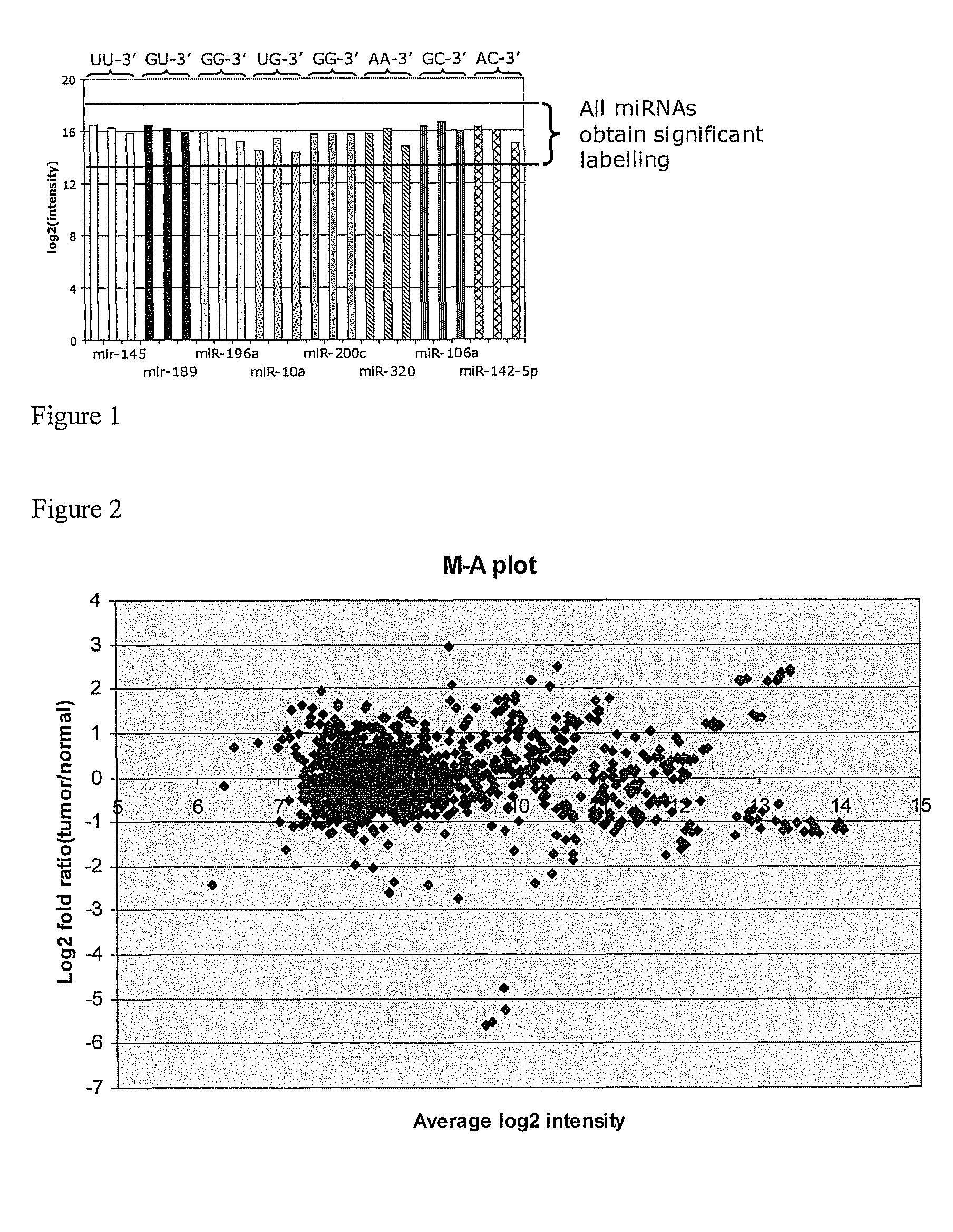Locked nucleic acid reagents for labelling nucleic acids
a nucleic acid and lock nucleus technology, applied in the field of nucleic acid labelling reagents, can solve the problems of non-specific degradation of rna, and achieve the effect of increasing nuclease resistance to the target rna and reducing the risk of sample degradation
- Summary
- Abstract
- Description
- Claims
- Application Information
AI Technical Summary
Benefits of technology
Problems solved by technology
Method used
Image
Examples
example 1
Synthesis of a Compound of the Invention
[0101]
N-Trifluoroacetyl-6-aminohexanol (1)
[0102]6-aminohexanol (11.7 g; 100 mmol) is dissolved in dry dichloromethane (100 mL) and drop wise added ethyl trifluoroacetate (15 g; 105 mmol) in dry dichloromethane (50 mL) (˜30 min), and the mixture is stirred overnight. Water (10 ml) is added, and the mixture is stirred for 30 min. The solution is washed with water (2×100 mL), dried (Na2SO4), and concentrated. The residue is redissolved in acetonitrile (100 μL) and concentrated. The residue is placed on vacuum overnight, and a white crystalline solid is obtained. Yield 19 g.
DMT-O-mC(Bz)-O—PO(OCNEt)-O—C6-NHTFA (2)
[0103]LNA-mC(Bz) phosphoramidite (4.4 g; 5 mmol) and N-TFA-6-aminohexanol (2.1 g; 10 mmol) are co-evaporated with anh. MeCN (2×100 mL), and the residue is redissolved in anh. DCM (50 mL). DCI (10 mmol; 2.1 g) is added, and the mixture is stirred for 5 h (follow on HPLC). When complete reaction is obtained, 0.2 M I2 (25-30 mL until color is...
example 2
Labelling of Different RNA Oligonucleotides to Show Absence of Labelling Bias
Experimental
[0110]Eight RNA oligonucleotides (EQ16901, EQ16914, EQ16904, EQ16903, EQ16913, EQ16902, EQ18465, EQ18467—see table 1) with different 3′-end nucleotides were labelled with the reagent LNA-methyl-C-Cy3 in a 10 μL labelling reaction for 1 hour at 0° C. Each RNA oligonucleotide was labelled separately in an individual labelling reaction of 1 μM RNA oligonucleotide, 10 μM LNA-methyl-C-Cy3, 2 units / μL of T4 RNA ligase (New England Biolabs), 1×T4 RNA ligase ligation buffer (New England Biolabs), and 10% PEG. The labelling reactions were stopped by incubation at 65° C. for 15 minutes. The 10 μL labelling reaction was mixed with an equal volume of 2×TBE-urea loading buffer without dye (Novex, Invitrogen) and incubated for 3 minutes at 70° C. A volume of 5 μL (2.5 μL loading buffer 2.5 μL ligated sample) was loaded on a 15% TBE-urea polyacrylamide gel (PAGE) (Novex, Invitrogen). Electrophoresis was perfor...
example 3
Molecular Classification of Breast Cancer by MicroRNA Signatures
[0114]Breast cancer is the most frequent form of cancer among women worldwide. Currently, treatment and prognosis is based on clinical and histo-pathological graduation, such as TNM classification (tumor size, lymph node, and distant metastases status) and estrogen receptor status. To improve both the selection of therapy and the evaluation of treatment response, more accurate determinants for prognosis and response, such as molecular tumor markers, are needed. This example probes the expression patterns of microRNAs (miRNAs) in tumors and normal breast tissue to identify new molecular markers of breast cancer.
[0115]Biopsies from primary tumors and from the proximal tissue (1 cm from the border zone of tumor) were collected from female patients (age 55-69) undergoing surgery for invasive ductal carcinoma. Total-RNA was extracted following the “Fast RNA GREEN” protocol from Bio110. Assessment of miRNA levels was carried ...
PUM
| Property | Measurement | Unit |
|---|---|---|
| Tm | aaaaa | aaaaa |
| temperature | aaaaa | aaaaa |
| pH | aaaaa | aaaaa |
Abstract
Description
Claims
Application Information
 Login to View More
Login to View More - R&D
- Intellectual Property
- Life Sciences
- Materials
- Tech Scout
- Unparalleled Data Quality
- Higher Quality Content
- 60% Fewer Hallucinations
Browse by: Latest US Patents, China's latest patents, Technical Efficacy Thesaurus, Application Domain, Technology Topic, Popular Technical Reports.
© 2025 PatSnap. All rights reserved.Legal|Privacy policy|Modern Slavery Act Transparency Statement|Sitemap|About US| Contact US: help@patsnap.com



